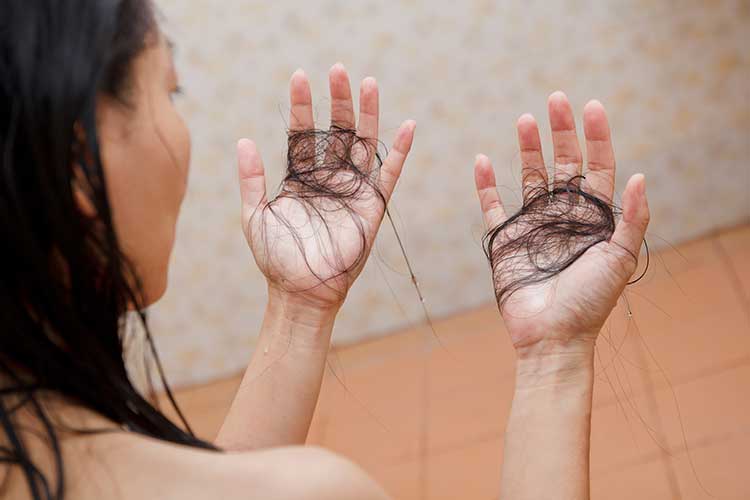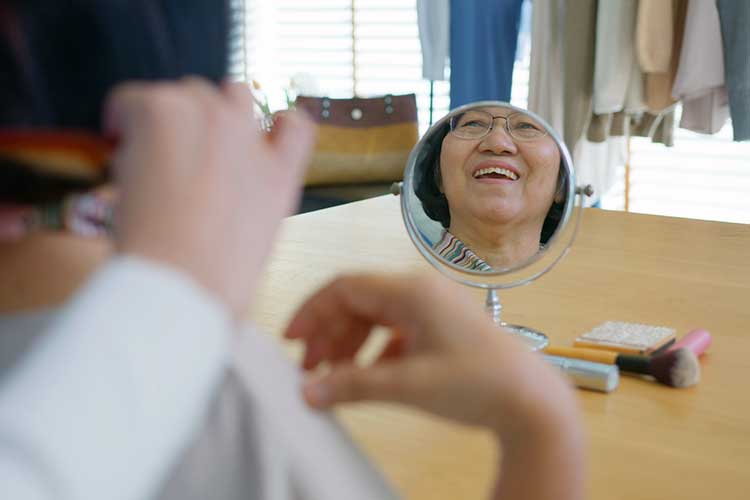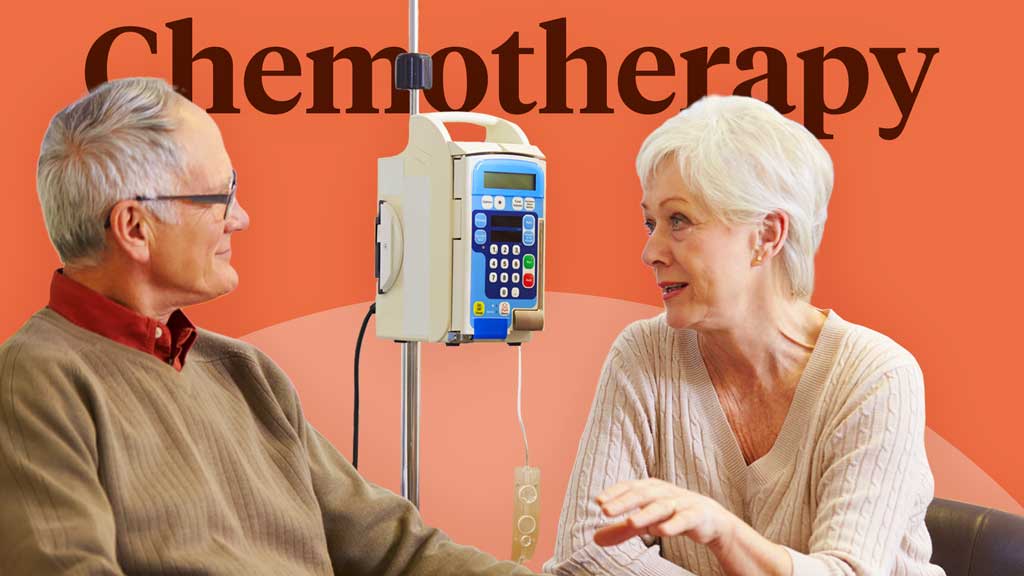What is Chemotherapy?
Chemotherapy is the use of a type of strong cytotoxic (toxic to cells) medicine to destroy or slow the growth of cancer cells (Healthdirect 2023; Cancer Council NSW 2023).
Chemotherapy works by specifically targeting fast-growing cells, which includes most cancer cells (Healthdirect 2023).
Most chemotherapy is systemic, i.e. administered into the bloodstream, but in some cases, it’s delivered directly to the cancer site (local chemotherapy) (Cancer Council NSW 2024).
Chemotherapy might be combined with, or used before or after, other cancer treatments including surgery, radiation therapy, hormone therapy, targeted therapy and immunotherapy (Cancer Council NSW 2024).
What Are the Aims of Chemotherapy?
Chemotherapy may be used to:
- Cure the cancer, if possible
- Control the cancer by shrinking tumours and impeding the growth and spread of cancerous cells
- Shrink the cancer before surgery or radiation therapy to increase the likelihood of successful treatment
- Destroy any remaining cancer cells after surgery or radiation therapy to reduce the risk of cancer coming back
- Provide palliation by reducing symptoms and improving the person’s quality of life, if the cancer is in an advanced stage.
(ACS 2019; Cancer Council Australia 2024)
How is Chemotherapy Administered?
Chemotherapy can be administered in a variety of ways, including:
- Orally, via tablets or liquid
- Intravenously (injected via a vein)
- Via a central venous catheter
- Intramuscularly (injected into the upper arm or thigh)
- Intra-arterial injection (injected into an artery that supplies blood to the cancer)
- Intraperitoneal injection (injected into the abdomen)
- Intrathecal injection (injected into the spine)
- Subcutaneous injection (injected under the skin, usually in the thigh or abdomen)
- A cream that is applied to the skin.
(Cancer Australia 2025; Cancer Council Australia 2024)
Intravenous administration is the most common method of delivering chemotherapy. However, the route of administration will depend on the type of cancer and the specific medicine being given (Cancer Council Australia 2024).
Frequency and Duration of Chemotherapy Treatment
The frequency and duration of chemotherapy depend on a number of factors, including:
- The type of cancer
- The way in which the cancer is responding to treatment
- The person’s ability to tolerate treatment
- The specific medicine being administered
- The aim of the chemotherapy
- Whether the person is experiencing side effects.
(Cancer Council Australia 2024; Cancer Council Queensland 2025)
Generally, chemotherapy is administered in treatment cycles with periods of rest in between so that the patient’s body has a chance to recover (Cancer Council Australia 2024).
Chemotherapy is often an outpatient procedure. The patient attends treatment during the day and then goes home (Cancer Council Australia 2024; Healthdirect 2023).
If the person requires chemotherapy for a prolonged period of time, a port (an intravenous tube that can stay in situ for weeks or months) may be inserted (Healthdirect 2023).
Side Effects of Chemotherapy

Chemotherapy targets all fast-growing cells, including those unrelated to cancer. Consequently, cells related to the skin, hair, gut and immune system, which are also fast-growing, may be adversely affected by treatment. This can lead to side effects such as:
- Nausea and vomiting
- Diarrhoea or constipation, which may be caused by anti-nausea medicine
- Fatigue
- Pain (e.g. headaches, muscle pain, nerve pain)
- Anaemia
- Mouth sores or ulcers
- Immunosuppression
- Easy bruising
- Hair loss or thinning
- Muscle weakness
- Skin sensitivity to sunlight
- Skin changes (e.g. itching, redness, dryness, acne)
- Nail changes
- Watery eyes
- Appetite changes
- Weight gain or loss
- Fertility changes
- Libido changes
- Emotional changes
- Cognition or memory changes
- Side effects related to the nervous system (tingling, burning, muscle weakness).
(Cancer Council Australia 2024; Cancer Australia 2025)
Most side effects are temporary, however, there is a possibility for long-term issues such as:
- Organ damage (heart, kidneys, liver, lungs or brain)
- Infertility
- Increased likelihood of developing other cancers.
(Cancer Australia 2025)
Caring for People Undergoing Chemotherapy
The side effects of chemotherapy can be unpleasant and upsetting, and as a result, people undergoing chemotherapy might require extra support and assistance.
- Helping the person to groom (e.g. makeup, hair) may help them feel more confident and in control, even if they’re staying in bed all day.
- Ensure the person’s teeth are brushed two times per day with a soft toothbrush.
- Prepare a mouth rinse for the person to use after brushing their teeth, comprising half a teaspoon of bicarbonate of soda with one cup of water.
- If helping the person bathe, ensure the water temperature is comfortable. They may have dry skin, so gently pat them dry and apply a water-based moisturiser.
- If the person’s skin is uncomfortable, encourage them to wear clothes in soft fabrics (e.g. cotton) and avoid uncomfortable, tight-fitting clothes.
- Ensure the person uses a mild shampoo and soft hairbrush.
- Ensure the person wears hats and sunscreen when outside.
- Consider serving frequent small snacks instead of large meals.
- Ensure the person stays hydrated.
- Plan activities for when the person has the most energy.
- Help the person to balance rest and activity, and maintain a social life.
- Maintain stringent infection control to reduce the risk of the person contracting an infection.
- Ensure the person has sufficient pain relief (refer to treating doctors if you have any concerns).
- Perform bowel care where necessary.
(WebMD 2024; Cancer Council Victoria 2024)

Personal Safety
It’s recommended that people who are not receiving cancer treatment avoid direct exposure to chemotherapy medicine, as the medicines used are toxic. Chemotherapy medicines may remain in the person’s body for up to a week after administration and are released via body fluids. To keep yourself safe:
- Always wear appropriate PPE
- Ensure the toilets are fully flushed after the person uses them, or if possible, provide them with a separate toilet
- Immediately dispose of gloves and perform hand hygiene after cleaning body fluids
- Avoid crushing or cutting chemotherapy tablets
- Store chemotherapy medicines safely
- Wash soiled bedding immediately for the longest washing machine cycle, using either hot or cold water with regular laundry detergent (do not handwash)
- If you come into contact with a body fluid, wash the affected area several times with soapy water.
(Cancer Council Australia 2024; Roswell Park 2019)
When to Escalate Care
Escalate care immediately if the person displays any of the following signs, which may indicate infection:
- Fever of 38°C or higher
- Chills or shivering
- Sweating, particularly at night
- Burning or stinging during urination
- Severe cough or sore throat
- Shortness of breath
- Excessive vomiting (lasts for more than a few hours)
- Severe abdominal pain, constipation or diarrhoea
- Unusual bleeding or bruising (e.g. nosebleeds, blood in urine, black stools)
- Prolonged lightheadedness or dizziness accompanied by a rapid heartbeat
- Any sudden deterioration.
(Cancer Council Australia 2024)
Test Your Knowledge
Question 1 of 3
What is a key reason chemotherapy might be given before surgery or radiation therapy?
Topics
Further your knowledge
 Free
Free Free
Free Free
Free Free
Free Free
Free
References
- American Cancer Society 2019, How Is Chemotherapy Used to Treat Cancer?, ACS, viewed 24 April 2025, https://www.cancer.org/treatment/treatments-and-side-effects/treatment-types/chemotherapy/how-is-chemotherapy-used-to-treat-cancer.html
- Cancer Australia 2025, Chemotherapy, Australian Government, viewed 24 April 2025, https://www.canceraustralia.gov.au/impacted-cancer/treatment/chemotherapy
- Cancer Council Australia 2024, Understanding Chemotherapy, Cancer Council Australia, viewed 24 April 2025, https://www.cancer.org.au/cancer-information/treatment/chemotherapy
- Cancer Council NSW 2024, About Chemotherapy, Cancer Council NSW, viewed 24 April 2025, https://www.cancercouncil.com.au/cancer-information/cancer-treatment/chemotherapy/about-chemotherapy/
- Cancer Council Queensland 2025, Chemotherapy, Cancer Council Queensland, viewed 24 April 2025, https://cancerqld.org.au/understanding-cancer/cancer-types-and-treatments/chemotherapy/
- Cancer Council Victoria 2024, Chemotherapy, Cancer Council Victoria, viewed 24 April 2025, https://www.cancervic.org.au/cancer-information/treatments/treatments-types/chemotherapy/side_effects_of_chemotherapy.html
- Healthdirect 2023, Chemotherapy, Australian Government, viewed 24 April 2025, https://www.healthdirect.gov.au/chemotherapy
- Roswell Park 2019, Home Precautions After Chemotherapy, Roswell Park Comprehensive Cancer Center, viewed 24 April 2025, https://www.roswellpark.org/cancer-care/treatments/cancer-drugs/post-chemo-guide
- WebMD 2024, Cancer: A Caregiver’s Daily Checklist, WebMD, viewed 24 April 2025, https://www.webmd.com/cancer/cancer-care
 New
New 
